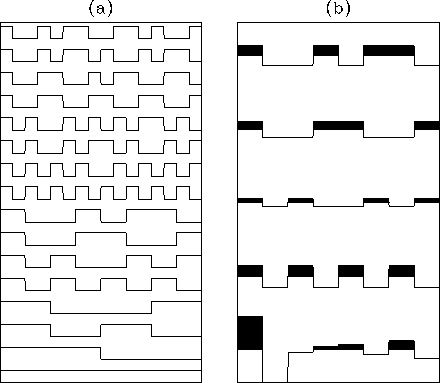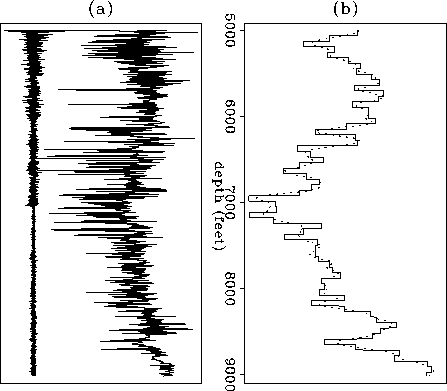




Next: COMPARING THE DIFFERENT SCHEMES
Up: Cunha: Walsh function decomposition
Previous: Linearized Inversion
The Walsh functions form an orthogonal and complete set of functions
representing a discretized function (Rao, 1983). As in the FFT, the discrete
function must be padded before decomposition, so that the total
number of samples reaches the nearest power of two. Figure ![[*]](http://sepwww.stanford.edu/latex2html/cross_ref_motif.gif) a
shows the first sixteen Walsh functions, which form a complete set
describing sequences with sixteen samples. Two important characteristics
of the Walsh functions are their compactness (representing the lower order
functions requires fewer samples), and the simplicity and quickness of
their construction.
walsh
a
shows the first sixteen Walsh functions, which form a complete set
describing sequences with sixteen samples. Two important characteristics
of the Walsh functions are their compactness (representing the lower order
functions requires fewer samples), and the simplicity and quickness of
their construction.
walsh
Figure 1 (a) The first sixteen Walsh functions. The frequency (order number)
increases from bottom to top: W0, W1, W2,1, W2,2, W3,1
to W3,4, and W4,1 to W4,8.
(b) Superposition of the four Walsh functions of order 3 to form the
wavelet transform component of the same order.

The following rules are used to generate the subset of Walsh
functions corresponding to order N:
-
The number of samples of the functions in this subset is
 .
. -
Except for order 0 (zero frequency), the number of Walsh
functions is given by
kN = 2N-1
.
-
Each function of order N-1 generates two functions of
order N, one by contraction and repetition, the other
by contraction and repetition with a change of sign. Thus


where i is the sample index and j is the index of one of the
functions of order N.
Beginning with the functions of order 0 (W0=1) and 1
(W1=1,-1), it is possible to generate a
complete set by using this iterative process.
There is a direct relationship between Walsh functions and the
particular wavelet transform described by Ottolini (1990),
which had a two-sample signal function as the
basis wavelet. In contrast to the Walsh set, the wavelet set has only one
component of order N, but the number of parameters associated
with this component is equal to the number of Walsh functions of the
same order. Figure ![[*]](http://sepwww.stanford.edu/latex2html/cross_ref_motif.gif) b shows that adding all
Walsh components of a given order results in the wavelet component
of the same order. In general, any wavelet component can be obtained
as a superposition of all the Walsh components of same order.
b shows that adding all
Walsh components of a given order results in the wavelet component
of the same order. In general, any wavelet component can be obtained
as a superposition of all the Walsh components of same order.
The Walsh functions have some properties that make them suitable
for certain geophysical applications. Lanning and Johnson (1983) used
the Walsh decomposition to develop an automated algorithm to identify
rock boundaries in well-log data. They claim that the discrete
transitions in signal level of these functions make them ideal for
describing layered media. Figure ![[*]](http://sepwww.stanford.edu/latex2html/cross_ref_motif.gif) a shows a sonic-log
from the Gulf of Mexico and its Walsh spectrum, while Figure
a shows a sonic-log
from the Gulf of Mexico and its Walsh spectrum, while Figure ![[*]](http://sepwww.stanford.edu/latex2html/cross_ref_motif.gif) b
compares the sonic smoothed with a triangle filter, with a band-limited
(order 0 to 6 for a maximum order of 12) Walsh
composition of the same sonic-log. Both curves show the same basic
features, but the Walsh composition manifest a ``blocky" structure
that can be better correlated with the geologic layers.
b
compares the sonic smoothed with a triangle filter, with a band-limited
(order 0 to 6 for a maximum order of 12) Walsh
composition of the same sonic-log. Both curves show the same basic
features, but the Walsh composition manifest a ``blocky" structure
that can be better correlated with the geologic layers.
well
Figure 2 (a) A sonic log (left), and its Walsh spectrum (right). The zero
frequency component was removed. (b) A Walsh band-limited version
(continuous line), and smoothed version (dotted line) of the sonic log.

In traveltime inversion the advantage of using
Walsh instead of Fourier decomposition lies in the simplicity
of the forward modeling computation, since the samples of the basis functions
can only assume values 1 or -1, and only a few samples are required
to describe the lower frequency components. Replacing
square functions by Walsh functions in the nonlinear scheme
described in the preceding section leads to a solution
similar to the set of equations (7).





Next: COMPARING THE DIFFERENT SCHEMES
Up: Cunha: Walsh function decomposition
Previous: Linearized Inversion
Stanford Exploration Project
12/18/1997

![[*]](http://sepwww.stanford.edu/latex2html/cross_ref_motif.gif) a
shows the first sixteen Walsh functions, which form a complete set
describing sequences with sixteen samples. Two important characteristics
of the Walsh functions are their compactness (representing the lower order
functions requires fewer samples), and the simplicity and quickness of
their construction.
a
shows the first sixteen Walsh functions, which form a complete set
describing sequences with sixteen samples. Two important characteristics
of the Walsh functions are their compactness (representing the lower order
functions requires fewer samples), and the simplicity and quickness of
their construction.
